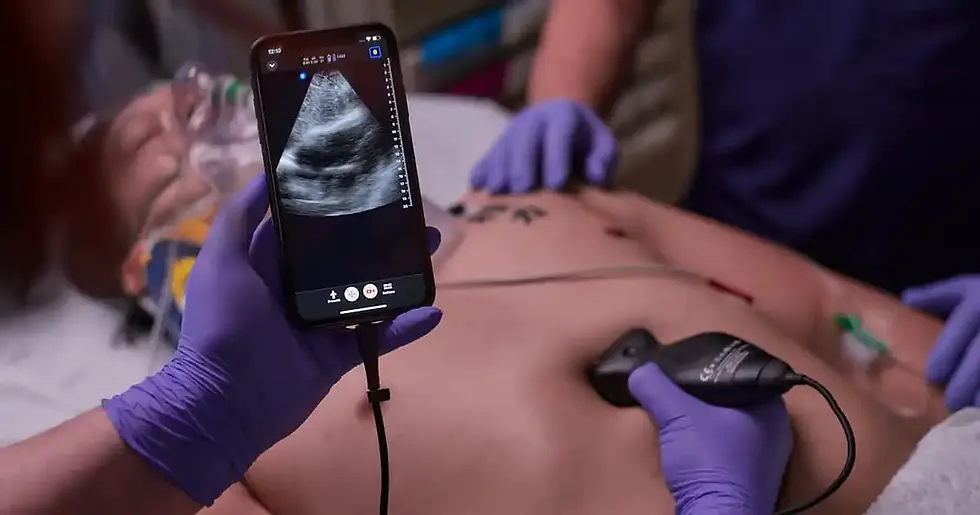Understanding Point-of-Care Ultrasound (POCUS) Utilization for Physician Assistants
Point-of-care ultrasound (POCUS) is a powerful diagnostic tool that has been increasingly utilized in medical care. POCUS allows for more rapid, more accurate, and more affordable assessment of complex medical problems, and, conveniently, many ultrasound (US) probes can fit into a white coat pocket. For physician assistants/ physician associates (PAs), the integration of POCUS into clinical practice enhances patient care and diagnostic accuracy.

What is POCUS?
Point-of-care ultrasound (POCUS) refers to the use of portable ultrasound devices at the bedside to assist in the diagnosis and management of patients. Unlike traditional ultrasound, which is performed by sonographers in dedicated imaging departments, POCUS allows healthcare providers to visualize anatomical structures and assess physiological functions in real-time. This immediacy can lead to quicker decision-making and improved patient outcomes.
POCUS is classically utilized for key views in the body, especially the vasculature, joint spaces, heart, lungs and pleura, abdominal organs, and eyes. POCUS can be used to identify and diagnose as well as to guide procedures. In the emergency department, POCUS can facilitate rapid assessment of a trauma patient through the EFAST technique.
Incorporation of POCUS into PA Program Training
The integration of POCUS into PA education is not as common as in medical schools for physicians (MDs/ DOs); however, the majority of PA students are interested in POCUS education (JPAE). For PA programs that do incorporate POCUS training, there is little standardization in the method and assessment of learning. POCUS training may involve:
Didactic Learning: Students learn the principles of ultrasound physics, image acquisition, and interpretation through lectures and interactive sessions.
Hands-On Training: Students practice using ultrasound machines on models and live patients under supervision, developing their skills in image acquisition and interpretation.
Clinical Rotations: PAs are encouraged to use POCUS during their clinical rotations, allowing them to apply their skills in real-world settings.
Some PA educators have sought to standardize POCUS education to provide a fundamental groundwork for PA student training, including consensus guidance on what should be part of the PA program curriculum and what may not be needed or may be out of scope (JPAE).
Specialties Utilizing POCUS
POCUS has applications across various medical specialties, including:
Emergency Medicine: Rapid assessment of trauma, cardiac function, and fluid status.
Internal Medicine: Evaluation of heart failure, pneumonia, and abdominal conditions.
Obstetrics and Gynecology: Monitoring fetal development and assessing gynecological conditions.
Pediatrics: Assessing pediatric patients for conditions like pneumonia and appendicitis.
Critical Care: Guiding procedures and assessing hemodynamic status.
Family Medicine: Cost-effective and efficient evaluation of acute and chronic disease states.
Incorporating POCUS into the Physical Exam
POCUS can enhance the traditional physical exam by providing immediate visual feedback. For example:
Cardiac Assessment: POCUS can help visualize heart function and fluid status, supplementing auscultation findings.
Respiratory Evaluation: POCUS can identify pleural effusions or pneumonia that may not be detected through physical examination alone. Using M mode, a provider can use POCUS to quickly assess for a pneumothorax.
Abdominal Exam: Ultrasound can assist in evaluating organ size, masses, or fluid collections.
Patient Care Outcomes Using POCUS
Research indicates that the use of POCUS can lead to improved patient care outcomes, including:
Reduced Time to Diagnosis: POCUS allows for rapid assessment, leading to quicker diagnoses, especially in the setting of trauma.
Decreased Need for Advanced Imaging: POCUS can sometimes mitigate or delay the need for more expensive and time-consuming imaging studies.
Improved Care Outcomes: POCUS may reduce the need for invasive interventions and decrease hospital length of stay (Crit Care Med).
Future Trends in POCUS Utilization
As technology continues to advance, the POCUS promises to become a key component of the clinical examination. Some proponents of POCUS suggest a portable US may become as useful as a stethoscope. Future trends in POCUS may include (POCUS Academy):
Increased Accessibility: The development of handheld ultrasound devices will make POCUS more accessible in various healthcare settings, including remote areas.
Artificial Intelligence (AI) Integration: AI can be incorporated into POCUS learning, facilitating diagnostic interpretation and expediting patient care.
Expanded Training Programs: PA programs and continuing education will likely incorporate more extensive POCUS training as its importance in clinical practice grows.
Promotion in Primary Care: With health disparities persisting well into this first quarter century, a rapid, affordable diagnostic tool such as POCUS can promise better, safer, and more affordable patient care in primary care offices, military medicine, austere medical environments, and other remote communities.
Conclusion
Point-of-care ultrasound is a transformative tool for PAs, enhancing diagnostic capabilities and improving patient care outcomes. As PAs continue to embrace POCUS in their practice, its integration into training programs and clinical settings will undoubtedly evolve, paving the way for more efficient and effective healthcare delivery.
For more information about POCUS and POCUS training, consider a POCUS certificate course, joining the Society for Point-of-Care Ultrasound (SPOCUS), read a POCUS textbook, or study online references, such as Point-of-Care Ultrasound Academy or POCUS101.
%20PNG.png)